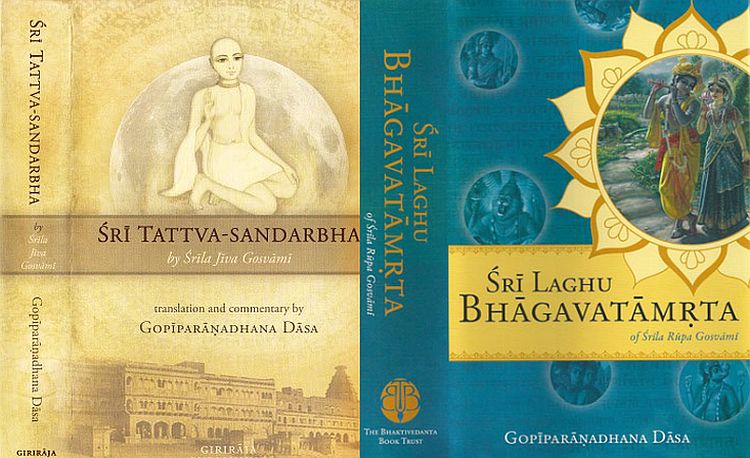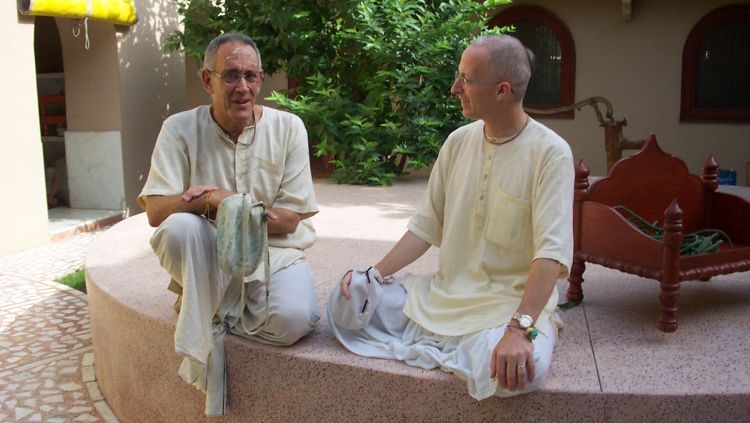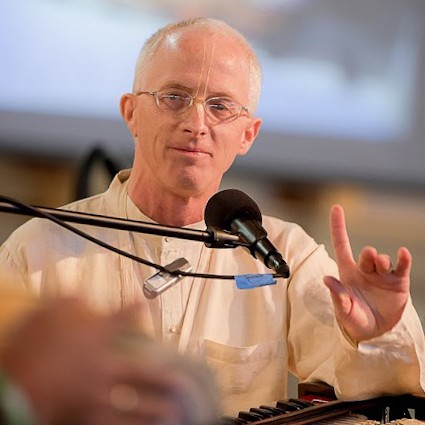Mukunda Datta Das Translates Classic Works of the Acaryas for the BBT
By Madhava Smullen | Июл 13, 2018

The Bhaktivedanta Book Trust is filled with extraordinary devotees continuing Srila Prabhupada’s legacy and bringing us the works of the acaryas.
One of these, translator and editor Mukunda Datta Das, got a running start at his life’s work. Growing up in Southern California, he was spiritually inclined from a very early age, becoming vegetarian and practicing yoga at just ten years old.
At thirteen, in a private high school, he began learning Sanskrit, and came across Bhagavad-gita As It Is. He had already read several editions of the Gita, but when he opened Srila Prabhupada’s, he says, “The lights came on.”
Mukunda Datta was deeply impressed by the comprehensive, authentic, and nectarean presentation of the science of Krishna-bhakti (love of God) explained in Prabhupada’s books. When he met Prabhupada soon after at the Los Angeles temple, the combination was so powerful that he joined ISKCON in 1976 at only fifteen.
After traveling with the Radha Damodara Sankirtan party, and serving as a pujari and gurukula teacher, Mukunda Datta married and returned to college in 1990 so that he could get a dependable source of income.
Wanting something that would keep him close to Krishna, he majored in South Asian literature and languages. More specifically, he studied bhakti literature, as well as Sanskrit, Bengali, and medieval Hindi dialects like Braja Basha, the language spoken in Lord Krishna’s hometown of Vrindavana. His aim was to become a professor of Indology, so that he could teach bhakti literature for a living.
But when Gopiparanadhana Das, a devotee he deeply respected, invited him to join the BBT in 2001, switching tracks was an easy decision – he couldn’t imagine any more important work.
“Gopiparanadhana Prabhu oversaw the BBT imprint Giriraj Publishing from his Sanskrit School at Govardhana,” Mukunda says. “Life there was very rustic, difficult and austere. But it was extremely rewarding in the sense that I learned so much. The depth of knowledge and focus on our traditional literature that he brought was something I couldn’t get in a university setting.”
Mukunda Datta began by helping Gopiparanadhana with his work on Jiva Goswami’s Bhagavat-Sandarbha and Rupa Goswami’s Laghu-Bhagavatamrita. After a hiatus to care for his ailing mother, he returned to the BBT in 2011. By this time, Gopiparanadhana, who was very dear to him, had passed away.

Mukunda Datta Das (right) with Gopiparanadhana Das
Today, Mukunda still lives at Govardhana, working remotely with South Pacific/Australian BBT staff around the world, and completing many of the late scholar’s projects under the direction of Devamrita Swami.
One of these was the Laghu-Bhagavatamrita, published by the BBT last year.
“Brihad-Bhagavatamrita, by Sanatana Goswami, was published back in the early 2000s,” explains Mukunda Datta. “It deals with the relationships between the devotees in the spiritual world, and the progression of Krishna conscious realization culminating in Vraja Prema. Laghu-Bhagavatamrita, written by Sanatana’s younger brother Rupa Goswami, is a sort of sequel, focusing on the relationships between Lord Krishna’s different incarnations, and establishing Krishna’s supremacy.”
These works are being made available by the BBT according to Srila Prabhupada’s desire. In the purport to Chaitanya Charitamrita Adi-lila 5.203, ISKCON’s Founder-Acharya writes of the Brihad-Bhagavatamrita, “Anyone who wants to know about the subject matter of devotees, devotional service and Krishna must read this book.”
Mukunda Datta has also just completed work on the Bhagavat-Sandarbha, to be published by the BBT within the next year. The book is the second of six sandarbhas, or essays, in which Jiva Goswami spells out the gist of Gaudiya Vaishnava philosophy. Srila Prabhupada, once again, did not hold back on their importance.
“These six sandarbhas are recognized as the most scholarly work in the world,” he said in a 1972 conversation in Vrindavana. “There is no comparison of [Jiva Goswami’s] philosophical approach with respect to the вайшнавы school. All subject matters related to vaisnavism are very elaborately discussed in the sat-sandarbha. That is the greatest gift of Srila Jiva Goswami.”

Nityananda Das from Latvia, who works with Mukunda Datta on translations of the acarya’s books
In his purport to Chaitanya-Charitamrita Madhya-lila 1.43, Prabhupada gives an in-depth breakdown of the contents of each sandarbha. Mukunda Datta summarizes:
“In Tattva-Sandarbha, which the BBT has already published, Jiva Goswami talks about pramana, or epistemology,” he says. “How do we know anything about God? How do we know about spiritual life? In Bhagavat-Sandarbha, he talks about Bhagavan, establishing the truth of the Lord’s transcendental status, inconceivable internal energies, devotees, and spiritual abode.”
The third book, Paramatma-Sandharba, which discusses the Lord within the heart, is also underway. After that, Mukunda Datta will edit a translation by Bhanu Swami of Rupa Goswami’s "Бхакти-расамрита-синдху".
Mukunda acknowledges that some may question the need for this, since we already have Srila Prabhupada’s summary study, The Nectar of Devotion. But just as Prabhupada first gave us the Krishna book and then the more in-depth tenth canto of Srimad-Bhagavatam, the BBT hopes to follow in his footseps and publish the entire source material for The Nectar of Devotion.
“The full Bhakti-rasamrita-sindhu is a massive, multi-volume project, which will take at least two to three years to complete,” Mukunda Datta says.

Mukunda Datta Das
All these works are essential for serious students of Gaudiya Vaishnava philosophy. “A sincere devotee must, therefore, be prepared to hear the Vedic literature like the Upanisads, Vedanta and other literatures left by previous authorities or Goswamis for the benefit of his progress,” Srila Prabhupada writes in his purport to Srimad-Bhagavatam 1.2.12. “Without hearing such literatures, one cannot make actual progress.”
In translating and editing these works, Mukunda must be very faithful and careful to properly present the writings of the acaryas.
“In Sanskrit and Hindi, the word for purport is tatparya, which means the intention of the author,” he says. “So we have to make sure we understand the author’s intention very clearly. And there is no such word as translation in Sanskrit – the word is anuvada, which means retelling. So we want to retell the same thing without changing it in any way. That’s the challenge.”
Part of the way Mukunda Datta and other BBT translators and editors do this is by consulting several different editions of each work, as well as different commentaries of the predecessor acaryas.
“The revelation that you get when you see what the acaryas are trying to communicate can be very exhilarating,” he says. “But it’s a very slow, tedious process. So one has to be very patient, and very attentive.”
This attentiveness, however, completely absorbs one in transcendental subject matters.
“I’m very fortunate to have such a service,” Mukunda Datta says. “I can’t imagine being so deeply absorbed in editing mundane stuff – that would drive me crazy. But editing and translating for the BBT is a way that I can become deeply absorbed in understanding Krishna consciousness, which is what we’re all supposed to do anyway. And at the same time, it’s preaching – because many people will read the result.”
Email info@bbtbooks.org to order your copies of Brihad-Bhgavatamrita, Laghu-Bhagavatamrita and Tattva Sandarbha today!















